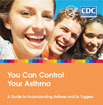Primary Prevention in Infants of Mothers Who Have Asthma
Medical clinics/physicians’ offices
Prenatal Intervention with First-degree Relatives who have Diagnosed Asthma
Article Citation:Chan-Yeung M, Manfreda J, Dimich-Ward H, Ferguson A, Watson W, Becker A. A randomized controlled study on the effectiveness of a multifaceted intervention program in the primary prevention of asthma in high-risk infants. Archives of Pediatric Adolescent Medicine 2000;54:657-63
Intervention Setting:
The intervention was conducted in Vancouver, British Columbia and Winnipeg, Manitoba and included a) women registered to give birth at a community-based maternity hospital, and b) women attending university-based antenatal clinics in offices of obstetricians.
Target Population:
The intervention targeted pregnant women identified in prenatal clinics who would be mothers of infants determined to be at high-risk for asthma. Infants are defined as persons from birth through 1 year of age. High-risk infants are defined as those with at least one first-degree relative with asthma or two first-degree relatives with other IgE-mediated allergic disease.
Program Description:
The objective of this study was to determine the effectiveness of a multifaceted intervention program in the primary prevention of asthma in high-risk infants. The program included the following strategies: avoiding of house dust mites (HDMs), pet allergens, and environmental tobacco smoke; encouraging breastfeeding and supplementation with partially hydrolyzed formula; and avoiding foods that sensitize. After completing the baseline assessment, the intervention group participants were given instruction regarding steps to reduce exposure to HDMs; in addition, they were advised to remove pets from the home and to eliminate exposure to environmental tobacco smoke. Mothers were advised either to breast feed for at least 4 months or use partially hydrolyzed formula and avoid eating certain foods.
Evaluation Design:
The study was a randomized controlled trial. Home visits were conducted before the birth of the infant and at 2 weeks and 4, 8, and 12 months after birth. Homes were assessed using a questionnaire and a walk-through survey. During each visit, data were collected regarding evidence within the home of leaks resulting in water damage and mildew and molds. The type of heating/air conditioning system functioning within the home was also documented. During further home visits, a questionnaire addressing the infant’s health and environment was administered.
Sample Size:
The study participants included 251 infants in the intervention group and 242 infants in the control group.
Outcome Measures/Results:
Outcome measures were probable or possible asthma, rhinitis without apparent colds, and skin test results positive for common inhalant allergens. Thirty-eight (15.1%) of the 251 infants assessed in the intervention group met the criteria for possible or probable asthma; 49 (20.2%) of the control-group infants met the same criteria. In the intervention group, 16.7% of the infants, and in the control group, 27.3% of the infants developed rhinitis without colds, a modest but statistically significant difference. Incidence of skin test results positive to one or more inhalant allergens was similar in both groups (4.4% in the intervention group and 4.6% in the control group).
Availability of Protocol/Materials:
The protocol and materials are not available for widespread distribution.
Case Study:
None
- Page last reviewed: April 24, 2009
- Page last updated: April 27, 2009
- Content source: National Center for Environmental Health
Contact Us:
- Centers for Disease Control and Prevention
1600 Clifton Rd
Atlanta, GA 30333 - 800-CDC-INFO
(800-232-4636)
TTY: (888) 232-6348
24 Hours/Every Day - cdcinfo@cdc.gov


